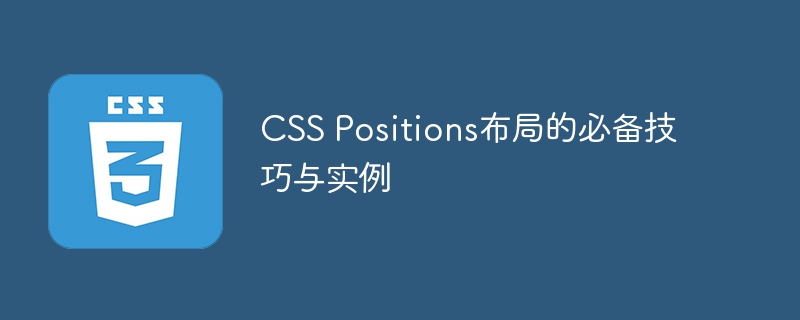

Essential skills and examples of CSS Positions layout
In web development, layout is a very important aspect. CSS Positions (position) is a commonly used layout technology that implements the layout of web pages by specifying the position of elements on the page. This article will introduce the essential skills of CSS Positions layout and provide practical code examples.
1. Basic concepts of CSS Positions
CSS Positions mainly include the following attributes: static, relative, fixed, absolute and sticky. These properties can be specified by setting the position attribute of the element.
static: Default attribute, elements are laid out according to normal document flow. This layout is not affected by other attributes, and elements will be displayed according to the order of the HTML document. relative: Relative positioning, the element will be positioned relative to its normal position. You can adjust the offset of an element relative to its normal position by setting the top, right, bottom, and left properties. fixed: Fixed positioning, the element will be positioned relative to the browser window. This means that as the user scrolls the page, the element stays in the same position. absolute: Absolute positioning, the element is positioned according to its nearest non-static positioned parent element. If no such parent element is found, the element is positioned relative to the browser window. sticky: Sticky positioning, the element will be positioned according to a specific position during scrolling. By setting the top, right, bottom, and left properties, you can specify the offset of the element when scrolling. 2. Common techniques for CSS Positions layout
relative attribute to create a container and set the width and height, and then place elements within the container. In this way, the container can be used as a relative positioning reference to position the internal elements. absolute attribute to control the absolute position of the element. By setting the top, right, bottom, and left properties, you can precisely control the position of an element on the page. fixed attribute. Typically, you can anchor an element to the upper left corner of the page by setting the top, right, bottom, and left attributes to 0. sticky attribute to achieve the ceiling effect, that is, when the page scrolls down, the element will stay in a certain position. It should be noted that the sticky attribute needs to be set simultaneously with the top, right, bottom and left attributes to control the offset of the element. 3. Example code of CSS Positions layout
The following are several common layout examples for reference:
<div class="container">
<div class="box1">Box 1</div>
<div class="box2">Box 2</div>
</div>
<style>
.container {
position: relative;
width: 500px;
height: 200px;
}
.box1 {
position: relative;
top: 50px;
left: 50px;
background-color: red;
}
.box2 {
position: relative;
top: 100px;
left: 100px;
background-color: blue;
}
</style>
<div class="container">
<div class="fixed-box">Fixed Box</div>
</div>
<style>
.container {
height: 2000px;
}
.fixed-box {
position: fixed;
top: 0;
left: 0;
width: 200px;
height: 100px;
background-color: red;
}
</style>
<div class="container">
<div class="header">Header</div>
<div class="content">Content</div>
</div>
<style>
.container {
height: 2000px;
}
.header {
position: sticky;
top: 0;
width: 100%;
height: 50px;
background-color: red;
}
.content {
padding-top: 50px;
}
</style>By using the above Techniques and code examples can flexibly realize various web page layout effects, improving user experience and page readability.
Summary:
CSS Positions layout is one of the indispensable skills in web development. By mastering the characteristics and usage of different attributes, and flexibly using related techniques, various complex layout effects can be achieved. In the actual development process, we can choose different positioning attributes according to specific needs to achieve the required layout effect and improve the usability and aesthetics of the web page.
The above is the detailed content of Essential skills and examples of CSS Positions layout. For more information, please follow other related articles on the PHP Chinese website!




